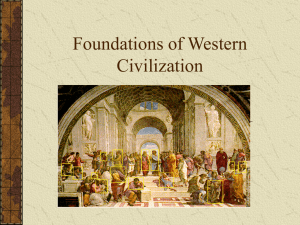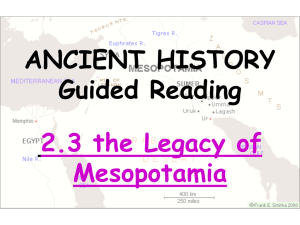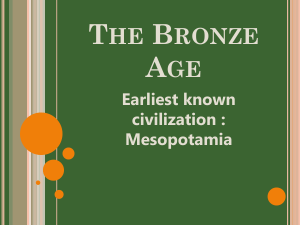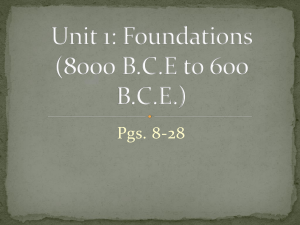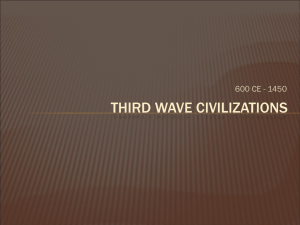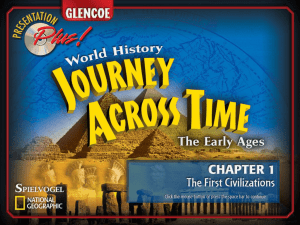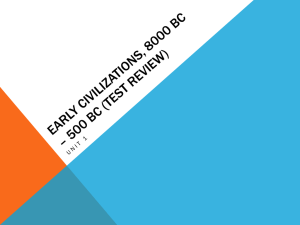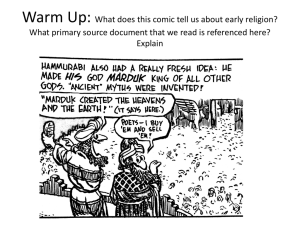Early Humans
advertisement
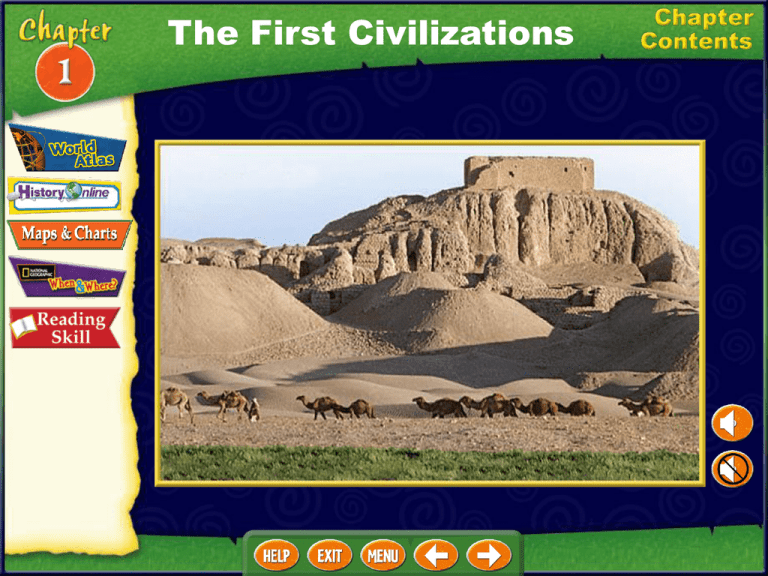
The First Civilizations Early Humans Get Ready to Read (cont.) Focusing on the Main Ideas • Paleolithic people adapted to their environment and invented many tools to help them survive. • In the Neolithic Age, people started farming, building communities, producing goods, and trading. Early Humans Early Humans • History is the story of humans in the past, and historians are the people who study and write about humans of the past. • Archaeologists hunt for evidence buried in the ground. (pages 9–11) Early Humans Early Humans (pages 9–11) Early Humans Early Humans (cont.) • Anthropologists study how humans developed and related to each other. • The early period of human history is called the Stone Age. • The earliest part of the Stone Age is called the Paleolithic period. • Paleolithic people were nomads, traveling from place to place to hunt and search for food. (pages 9–11) Early Humans Early Humans (cont.) • Paleolithic women cared for children and gathered berries, nuts, and grains. • Paleolithic men hunted animals using clubs, spears, traps, and bows and arrows. • Paleolithic people adapted to their environment. (pages 9–11) Early Humans Early Humans (cont.) • Those in warm climates wore little clothing and had little need for shelter. • Those in cold climates used caves for shelter. • Over time, they learned to create shelters from animal hides and wooden poles. (pages 9–11) Early Humans Early Humans (cont.) • Paleolithic people discovered fire, which kept them warm, lit the darkness, and cooked food. • Long periods of extreme cold are called the Ice Ages. • During the Ice Ages, thick sheets of ice covered parts of Europe, Asia, and North America. (pages 9–11) Early Humans Early Humans (cont.) • Paleolithic people developed spoken language and expressed themselves through art, which may have had religious meaning. • During this time, humans created tools such as spears and hand axes using stone called flint. (pages 9–11) Early Humans Neolithic Times • In the beginning of the Neolithic Age, people began to domesticate, or tame, animals. • Domesticated animals carried goods and provided meat, milk, and wool. • People in different parts of the world began growing crops about the same time. • Historians call this change the farming revolution. (pages 13–15) Early Humans Neolithic Times (cont.) • Because farmers needed to stay close to their fields, they built permanent homes in villages. • One of the oldest villages is Jericho in present-day Israel and Jordan. • Another Neolithic village is Çatal Hüyük in present-day Turkey. • Permanent villages provided people with security and steady food. (pages 13–15) Early Humans Neolithic Times (cont.) • The surplus food led to a larger population. • Not all people in a village were farmers. • Some made pottery, mats, and cloth. • They traded these goods for things they did not have. (pages 13–15) Early Humans Why was farming important to the Neolithic people? Farming allowed people to settle in one place, and it provided a steady food supply. Early Humans Who are archaeologists and what do they study? Archaeologists are scientists who hunt for, dig up, and study artifacts. Early Humans How did domesticating animals help the Neolithic people? Animals supplied meat, milk, and wool. They also carried goods and pulled carts. Early Humans Explain Why were Paleolithic people nomads? They moved around to hunt animals and gather other foods. Mesopotamian Civilization Get Ready to Read (cont.) Focusing on the Main Ideas • Civilization in Mesopotamia began in the valleys of the Tigris and Euphrates Rivers. • Sumerians invented writing and made other important contributions to later peoples. • Sumerian city-states lost power when they were conquered by outsiders. Mesopotamian Civilization Mesopotamia’s Civilization • Civilizations are complex societies with cities, governments, art, religion, class divisions, and a writing system. • Rivers were important because they made for good farming conditions. • They also made it easy for people to travel and trade. • Governments were formed because someone had to make plans and decisions for the common good. (pages 17–20) Mesopotamian Civilization Mesopotamia’s Civilization (cont.) • Mesopotamia is a flat plain bounded by the Tigris and Euphrates rivers. • Floods in Mesopotamia were frequent and unpredictable. • Farmers learned to control the rivers with dams and channels. • They also used the rivers to irrigate, or water, their crops. (pages 17–20) Mesopotamian Civilization Mesopotamia’s Civilization (cont.) • Many cities formed in a southern region of Mesopotamia known as Sumer. • Sumerian cities were city-states, with their own governments. • Sumerian cities often fought each other. • To protect themselves, the city-states built walls around themselves. (pages 17–20) Mesopotamian Civilization Mesopotamia’s Civilization (cont.) • Sumerians believed in many gods. • Each citystate had a ziggurat, or grand temple, to honor the gods. (pages 17–20) Mesopotamian Civilization Mesopotamia’s Civilization (cont.) • Most Sumerians were farmers, but some were artisans, or skilled workers. • Others were merchants and traders. • Sumerian city-states had three classes. • The upper class consisted of kings, priests, and government officials. • The middle class consisted of artisans, merchants, fishers, and farmers. (pages 17–20) Mesopotamian Civilization Mesopotamia’s Civilization (cont.) • The lower class consisted of slaves. (pages 17–20) Mesopotamian Civilization A Skilled People • Mesopotamia has been called the cradle of civilization because of the influence of Sumerian ideas on other areas. • Writing helps people keep records and pass on ideas. • Sumerians developed a writing system called cuneiform. • Only a few people, called scribes, learned to write. (pages 20–21) Mesopotamian Civilization Sargon and Hammurabi • Sargon, the king of the Akkadians, conquered all of Mesopotamia and set up the world’s first empire. • An empire is a group of many different lands under one ruler. • After Sargon, another group of people became powerful. • They built the city of Babylon on the Euphrates River. (page 23) Mesopotamian Civilization Sargon and Hammurabi (cont.) • The Babylonian king, Hammurabi, conquered lands north and south of Babylon to create the Babylonian Empire. • The Code of Hammurabi was a collection of laws covering crimes, farming, business activities, and marriage and family. • Many punishments in the code were cruel, but the code was an important step in the development of a justice system. (page 23) The First Empires Get Ready to Read (cont.) Focusing on the Main Ideas • Assyria’s military power and well organized government helped it build a vast empire in Mesopotamia by 650 B.C. • The Chaldean Empire built important landmarks in Babylon and developed the first calendar with a seven-day week. The First Empires The Assyrians • The Assyrian empire arose about 1,000 years after the rule of Hammurabi. • The Assyrian army was the first large army to use iron weapons. • Their weapons were stronger than those of copper and tin. (pages 27–28) The First Empires The Assyrians (cont.) • They fought with spears, daggers, bows and arrows, chariots and soldiers on horseback. (pages 27–28) The First Empires The Assyrians (cont.) • The capital of the Assyrian empire was Nineveh. • The empire was divided into provinces, which are political districts. • Each province was governed by an official who collected taxes and enforced laws. (pages 27–28) The First Empires The Assyrians (cont.) • The Assyrians built large temples and palaces, with statues and wall carvings. • One of the first libraries was in Nineveh and held 25,000 tablets of stories and songs. • People began to rebel because of Assyria’s cruel treatment. • The Chaldeans rebelled and took control of Nineveh in 612 B.C. (pages 27–28) The First Empires The Chaldeans • Nebuchadnezzar was the king of the Chaldeans. • The Chaldeans, who were descendents of Babylonians, rebuilt Babylon. • The city became the center of the Chaldeans’ empire. • The city was surrounded by a huge wall. Inside the wall were palaces, temples, and a huge ziggurat. (pages 29–30) The First Empires The Chaldeans (cont.) • Nebechadnezzar ordered the Hanging Gardens to be built for his wife, who missed her green, mountainous homeland. • The Hanging Gardens were one of the Seven Wonders of the Ancient World. (pages 29–30) The First Empires The Chaldeans (cont.) • The Chaldeans were merchants, artisans, and traders. • Babylon was on a major trade route and profited from trade. (pages 29–30) The First Empires Why was the Assyrian army a powerful fighting force? It had a well-organized army with advanced weapons. The First Civilizations Review Vocabulary Define Match the vocabulary word that completes each sentence. E 1. A ___ kept records __ in cuneiform. C 2. An ___ is a group of __ many different lands under one ruler. __ B 3. Assyrian kings divided their empire into political districts called ___. A. B. C. D. E. historians provinces empire city-state scribe The First Civilizations Review Vocabulary Define Match the vocabulary word that completes each sentence. A 4. ___ are people who __ study and write about the human past. D 5. A ___ had its own __ government and was not part of any larger unit. A. B. C. D. E. historians provinces empire city-state scribe The First Civilizations Review Main Ideas Section 1 Early Humans What were the major differences between people who lived in the Paleolithic period and those who lived in the Neolithic period? People who lived in the Paleolithic period were hunters and gatherers. Neolithic people were farmers and traders who built communities. The First Civilizations Review Main Ideas Section 2 Mesopotamian Civilization Where were the first civilizations in Mesopotamia? in the valleys of the Tigris and Euphrates Rivers The First Civilizations Review Main Ideas Section 3 The First Empires What helped Assyria build an empire in Mesopotamia? its military power and well organized government The First Civilizations Review Main Ideas Section 3 The First Empires What scientific advancement did the Chaldeans make? They mapped the stars, planets, and phases of the moon; created the sundial; and used the seven-day week. The First Civilizations Analyze Why was the switch from hunting and gathering to farming important enough to be called the farming revolution? Farming allowed early humans to settle into villages, which was a new way of living that led to the rise of civilizations. Click the map to view an interactive version. Click the map to view an interactive version. Ötzi the Iceman c. 3300 B.C Hammurabi Reigned c. 1792–1750 B.C
